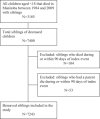Bereavement after sibling death: a population-based longitudinal case-control study
- PMID: 26833610
- PMCID: PMC4780295
- DOI: 10.1002/wps.20293
Bereavement after sibling death: a population-based longitudinal case-control study
Abstract
The objective of this study was to examine mental disorders and treatment use among bereaved siblings in the general population. Siblings (N=7243) of all deceased children in the population of Manitoba, Canada who died between 1984 and 2009 were matched 1:3 to control siblings (N=21,729) who did not have a sibling die in the study period. Generalized estimating equations were used to compare the two sibling groups in the two years before and after the index child's death on physician-diagnosed mental disorders and treatment utilization, with adjustment for confounding factors including pre-existing mental illness. Analyses were stratified by age of the bereaved (<13 vs. 13+). Results revealed that, in the two years after the death of the child, bereaved siblings had significantly higher rates of mental disorders than control siblings, even after adjusting for pre-existing mental illness. When comparing the effect of a child's death on younger versus older siblings, the rise in depression rates from pre-death to post-death was significantly higher for siblings aged under 13 (p<0.0001), increasing more than 7-fold (adjusted relative rate, ARR=7.25, 95% CI: 3.65-14.43). Bereaved siblings aged 13+ had substantial morbidity in the two years after the death: 25% were diagnosed with a mental disorder (vs. 17% of controls), and they had higher rates of almost all mental disorder outcomes compared to controls, including twice the rate of suicide attempts (ARR=2.01, 95% CI: 1.29-3.12). Siblings in the bereaved cohort had higher rates of alcohol and drug use disorders already before the death of their sibling. In conclusion, the death of a child is associated with considerable mental disorder burden among surviving siblings. Pre-existing health problems and social disadvantage do not fully account for the increase in mental disorder rates.
Keywords: Sibling; bereavement; depression; epidemiology; mental disorder; suicide.
© 2015 World Psychiatric Association.
Figures


Similar articles
-
Parents bereaved by offspring suicide: a population-based longitudinal case-control study.JAMA Psychiatry. 2013 Feb;70(2):158-67. doi: 10.1001/jamapsychiatry.2013.275. JAMA Psychiatry. 2013. PMID: 23229880
-
Spouses bereaved by suicide: A population-based longitudinal cohort comparison of physician-diagnosed mental disorders and hospitalized suicide attempts.J Psychiatr Res. 2020 Nov;130:347-354. doi: 10.1016/j.jpsychires.2020.07.028. Epub 2020 Aug 8. J Psychiatr Res. 2020. PMID: 32882576
-
The Indirect Effect of Positive Parenting on the Relationship Between Parent and Sibling Bereavement Outcomes After the Death of a Child.J Pain Symptom Manage. 2016 Jan;51(1):60-70. doi: 10.1016/j.jpainsymman.2015.08.011. Epub 2015 Sep 18. J Pain Symptom Manage. 2016. PMID: 26387829
-
Psychosocial outcomes in cancer-bereaved children and adolescents: A systematic review.Psychooncology. 2018 Oct;27(10):2327-2338. doi: 10.1002/pon.4863. Epub 2018 Sep 11. Psychooncology. 2018. PMID: 30120901
-
Sibling involvement at the end of life.J Pediatr Oncol Nurs. 2005 Jul-Aug;22(4):222-6. doi: 10.1177/1043454205276956. J Pediatr Oncol Nurs. 2005. PMID: 15994340 Review.
Cited by
-
Description and evaluation of a French grief workshop for children and adolescents bereaved of a sibling or parent.BMC Palliat Care. 2021 Oct 15;20(1):159. doi: 10.1186/s12904-021-00861-9. BMC Palliat Care. 2021. PMID: 34649560 Free PMC article.
-
Prolonged grief, post-traumatic stress, and functional impairment in parents and siblings 8 years after the 2011 Utøya terror attack.Eur J Psychotraumatol. 2022 Dec;13(2):2152930. doi: 10.1080/20008066.2022.2152930. Epub 2022 Dec 13. Eur J Psychotraumatol. 2022. PMID: 38872603 Free PMC article.
-
Investigating Gene-Environment Interplay Between Bereavement and Polygenic Risk for Attention-Deficit/Hyperactivity Disorder on Externalizing Behaviors During Adolescence.JAACAP Open. 2024 May 27;3(2):323-334. doi: 10.1016/j.jaacop.2024.04.006. eCollection 2025 Jun. JAACAP Open. 2024. PMID: 40520970 Free PMC article.
-
Associations between parental depression, communication, and self-worth of siblings bereaved by cancer.J Fam Psychol. 2023 Dec;37(8):1190-1199. doi: 10.1037/fam0001137. Epub 2023 Sep 7. J Fam Psychol. 2023. PMID: 37676170 Free PMC article.
-
Mortality among twin individuals exposed to loss of a co-twin.Int J Epidemiol. 2023 Apr 19;52(2):600-610. doi: 10.1093/ije/dyac145. Int J Epidemiol. 2023. PMID: 35849345 Free PMC article.
References
-
- United Nations , Department of Economic and Social Affairs, Population Division. World fertility patterns 2013. www.un.org.
-
- U.S. Census Bureau . Family households by number of own children under 18 years of age: 2000. ‐2010. www.census.gov.
-
- Centers for Disease Control and Prevention . Deaths: final data for 2012. www.cdc.gov.
-
- Rostila M, Saarela J, Kawachi I. “The psychological skeleton in the closet”: mortality after a sibling's suicide. Soc Psychiatry Psychiatr Epidemiol 2014;49:919‐27. - PubMed
LinkOut - more resources
Full Text Sources
Other Literature Sources

